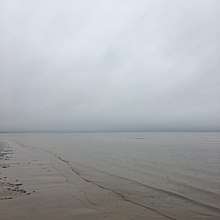Gulf of Riga
The Gulf of Riga, Bay of Riga, or Gulf of Livonia (Latvian: Rīgas jūras līcis, Estonian: Liivi laht, Russian: Рижский залив) is a bay of the Baltic Sea between Latvia and Estonia.
| Gulf of Riga | |
|---|---|
Location in Northern Europe. | |
| Location | Europe |
| Coordinates | 57°45′N 23°30′E |
| Primary inflows | Daugava, Pärnu, Lielupe, Gauja, Salaca |
| Surface area | 18,000 km2 (6,900 sq mi) |
| Average depth | 26 m (85 ft) |
| Max. depth | 54 m (177 ft)[1] |
| Water volume | 424 km3 (344,000,000 acre⋅ft) |
| Residence time | 30 years |
| Frozen | Most or all during winter |
| Settlements | Riga, Jūrmala, Pärnu, Kuressaare, Salacgrīva, Saulkrasti, Ainaži |
The island of Saaremaa (Estonia) partially separates it from the rest of the Baltic Sea. The main connection between the gulf and the Baltic Sea is the Irbe Strait.
The Gulf of Riga, as a sub-basin of the Baltic, also includes the Väinameri Sea in the West Estonian archipelago.
Geography
Extent
The International Hydrographic Organization defines the Gulf of Riga's western limit as "A line running from Lyser Ort (57°34'N), in Latvia, to the South extreme of Œsel Island, through this island to Pammerort (22°34'E), thence to Enmast Point, the S extreme of Dagö, through Dagö to Takhkona Point, the North extreme thereof, and on to Spithamn Point in Estonia".[2]
Salinity
The freshwater runoff entering the Baltic sea accounts for two percent of its volume.[3] A narrow connection to the North Sea means that water stays in the Baltic for an average of 30 years. These two characteristics work to make the Baltic Sea one of the largest brackish bodies of water in the world. The Gulf of Riga has an average salt concentration for the Baltic Sea, which is around six to ten parts per thousand. Freshwater has a concentration of 0.5 parts per thousand, and seawater is about 30 parts per thousand. A saline stratification layer is found at a depth of approximately 70 metres (230 ft).[3]
Winter
In winter, most or all of the Bay occasionally freezes. This is due to low salinity and the calming effect of the partial closure of the entrance of the gulf. During the winter, many people walk over the bay. The thickest recorded ice was 90 centimetres (35 in) thick in the winter of 1941–42.[4] Ice hole fishing has been a traditional source of winter food, and remains a common activity. The ice usually melts between March and April. In late March 2013, when the ice started to melt, 200 people had to be rescued from ice floes.[5]
See also
References
- Gulf of Riga | Baltic Sea
- "Limits of Oceans and Seas, 3rd edition" (PDF). International Hydrographic Organization. 1953. Archived from the original (PDF) on 8 October 2011. Retrieved 6 February 2010.
- C.Michael Hogan. 2011. Gulf of Riga. Encyclopedia of Earth. Eds. P.Saundry & C.J.Cleveland. National Council for Science and the Environment. Washington DC.
- http://www.estonica.org/en/Nature/The_Baltic_Sea/The_Gulf_of_Riga/
- https://www.theguardian.com/world/2013/mar/29/latvia-rescues-people-ice-floes
